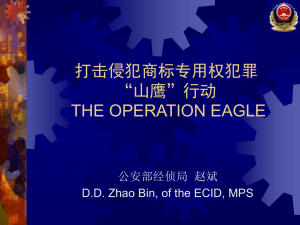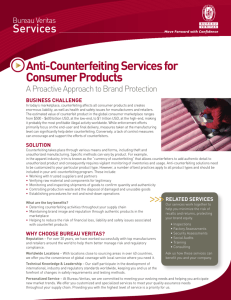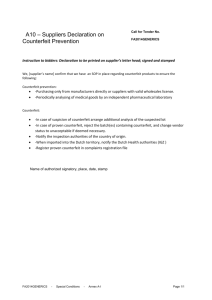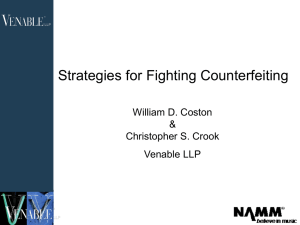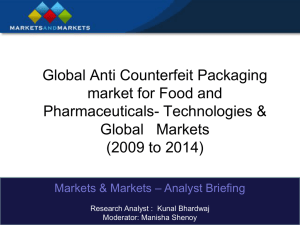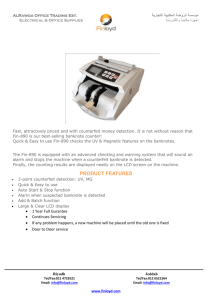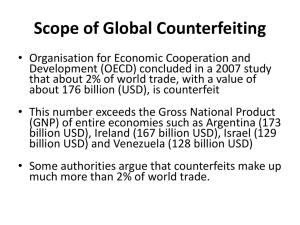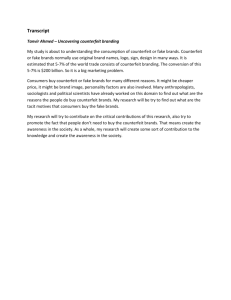International Telecommunication Union
advertisement
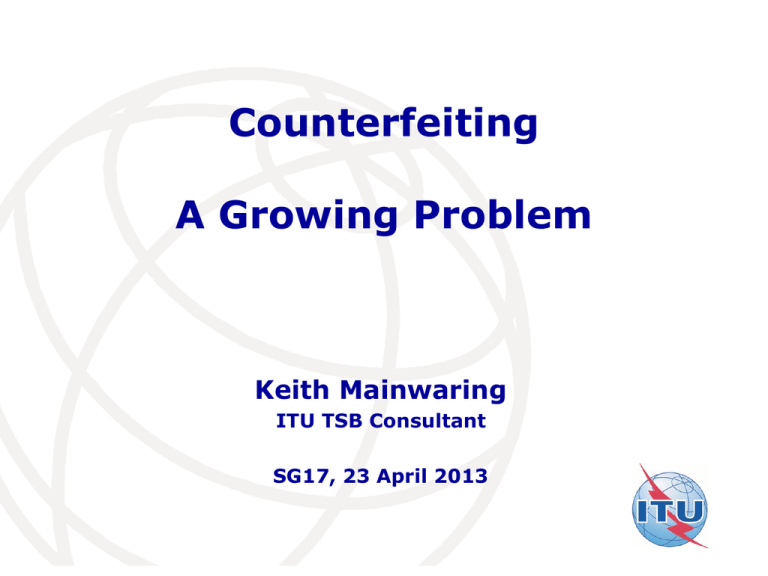
Counterfeiting A Growing Problem Keith Mainwaring ITU TSB Consultant SG17, 23 April 2013 International Telecommunication Union Contents Introduction What is counterfeiting? The impacts of counterfeiting Intellectual Property Rights conventions IPR enforcement Industry anti-counterfeiting forums E-waste and counterfeiting Measures to combat counterfeiting Standards organisations Guidelines for combating counterfeiting Conclusions ITU engagement Introduction Counterfeiting – the extent of the problem International trade in counterfeits US$250 billion; 1.95% [OECD 2007] US$600 billion; 5-7% [ICC Counterfeit Intelligence Bureau] Wide range of products Food, pharmaceuticals, clothes, electronic and automotive components, all manner of consumer products, even a whole store…. Consumer electronics - 22% of US Customs seizures in 2011 (16% increase by value over 2010) & about a third of the goods in this category were mobile phones ICT industry US$100 billion [KPMG & AGMA 2007] 200 million mobile phones [MMA 2010] Corresponds to about 13% of the mobile phone market in 2011 What is counterfeiting? “Counterfeit” The WIPO Intellectual Property Handbook describes counterfeiting as “first of all the imitation of a product. The counterfeit is not only identical in the generic sense of the term. It also gives the impression of being the genuine product……originating from the genuine manufacturer or trader” A counterfeit is: An unauthorised copy; Not conforming to the original manufacturer’s design, model, and/or performance standards; Not produced by the stated manufacturer or produced by unauthorised contractors; An off-specification, defective or used product sold as “new” or working; or Has incorrect or false markings and/or documentation Counterfeiting – an IPR contravention Intellectual Property (WIPO) 1. 2. Copyright, including “literary and artistic works such as novels, poems and plays, films, musical works, artistic works such as drawings, paintings, photographs and sculptures, and architectural designs” Industrial property, including “inventions (patents), trademarks, industrial designs, and geographic indications of source” Counterfeiting relates to trademark infringement whereas piracy relates to copyright infringement Associated with the category of industrial property is protection against unfair competition. The Paris Convention for the Protection of Industrial Property includes “the repression of unfair competition” within the area of “the protection of industrial property” and states that “any act of competition contrary to honest practices in industrial and commercial matters constitutes an act of unfair competition” The impacts of counterfeiting Impacts Economic impacts On rights holders as sale volumes and royalties, prices, brand value and reputation, costs and scope of operations may be affected On governments as tax revenues are reduced and need to finance activities to combat counterfeiting Counterfeiting may well have a negative effect on innovation, levels of foreign direct investment, economic growth and employment, and also redirect resources into organized criminal networks Consumers may find that the quality of counterfeit goods is substandard and also be presented with serious health and safety risks – the use of counterfeit products can be extremely dangerous Intellectual Property Rights Conventions IPR Conventions English Statute of Monopolies [1623] Precursor of patent law Paris Convention for the Protection of Industrial Property [1883] Aims to protect “patents, utility models, industrial designs, trademarks, service marks, trade names, indications of source or appellations of origin, and the repression of unfair competition” Requires contracting states to take measures against “direct or indirect use of a false indication of the source of the goods or the identity of the producer, manufacturer or merchant” WTO Trade-Related Aspects of of Intellectual Property Rights (TRIPS) [1994] First multilateral international trade agreements to protect IPR Sets the minimum levels of protection to be applied in all WTO member countries Requires governments to ensure that IPR infringement penalties are sufficient to deter violation; that commercial scale violations are considered to be criminal offenses; and that customs authorities should provide assistance to prevent imports of counterfeit goods Includes a procedure for IPR dispute resolution between WTO members IPR Enforcement IPR enforcement activities World Intellectual Property Organisation (WIPO) Advisory Committee on Enforcement (ACE) World Customs Organisation (WCO) European Union G8 Heiligendamm Process Interpol United Nations Commission for Europe (UNECE) National initiatives (just a few examples) France Comité National Anti Contrefaçon (CNAC) Institut National pour la Propriété Industrielle (INPI) UK Intellectual Property Office Kenya Anti-Counterfeiting Agency Industry Anti-Counterfeiting Forums Industry anti-counterfeiting initiatives International Chamber of Commerce (ICC) International Anti-Counterfeiting Coalition (IACC) Mobile Manufacturers Forum (MMF) International Electronics Manufacturing Initiative (iNEMI) Association of Service and Computer Dealers International and North American Association of Telecommunications Dealers (AscdiNatd) Alliance for Gray Market and Counterfeit Abatement (AGMA) British Electrotechnical and Allied Manufacturers Association (BEAMA) Anti-counterfeit Working Group UKEA (United Kingdom Electronics Alliance) Anti-Counterfeiting Group (ACG) UNIFAB - Union des Fabricants E-Waste and Counterfeiting Counterfeit electronic components US Senate Armed Services Committee – fall 2011 Department of Commerce’s Bureau of Industry and Security report: Estimated 1,800 cases of counterfeit electronic components being introduced in defence contract supply chains, involving more than a million components. The number of incidents rose from 3,868 in 2005 to 9,356 in 2008. Informal sector recycling of components. E-waste Largest and fastest growing manufacturing waste 41.5 million tons in 2011 Expected to rise to 93.5 million tons in 2016 In spite of the Basel Convention, much e-waste is exported 77% of that from England and Wales is exported to Africa (primarily Ghana and Nigeria) Source: BBC Example - Mobiles Many used and scrap mobile phones are shipped to countries in Africa from the EU under the guise of reuse. Some of these are repaired and find their way back into the market (although they may not meet the specifications of the manufacturer). Most are recycled in the informal sector. Metals in mobiles 40 elements including copper, tin, cobalt, indium, antimony, silver, gold and palladium. Combined sales of mobile phones and PCs in 2007 accounted for 3% of the world mine supply of gold and silver, 13% of palladium and 15% of cobalt. Basel Convention Programmes Partnership on Computing Equipment (PACE) Mobile Phone Partnership Initiative (MPPI) Guidelines have been produced on the: environmentally sound testing, refurbishment and repair of used computing equipment; environmentally sound material recovery and recycling of end-of-life computing equipment; transboundary movement of used and end-of-life computing equipment; environmentally sound management of used and end-of-life mobile phones; refurbishment of used mobile phones; collection of used mobile phones; material recovery and recycling of end-of-life mobile phones; awareness raising-design considerations; and transboundary movement of collected mobile phones. ITU initiatives The ITU signed an agreement with the Secretariat of the Basel Convention in March 2012 with the aim of promoting the environmentally sound management of e-waste and protecting the environment from the adverse effects of this waste ITU-T Study Group 5 is mandated to study the environmental impacts of information and communications technology Recommendation ITU-T L.1000 “Universal power adapter and charger solution for mobile terminals and other ICT devices” Recommendation ITU-T L.1100 “Procedures for recycling rare metals in ICTgoods” Measures to combat counterfeiting Fundamentals Product marking Unique identifiers Authentication Product lifecycle management Identifiers – some examples International Mobile Equipment Identity (IMEI) Electronic Product Codes (EPCs) ISO/IEC 15459 Unique identifiers for supply chain tracking Ubiquitous ID Center uCodes Automatic Identification and Data Capture (AIDC) Barcodes (linear/matrix) Radio Frequency Identification (RFID) Secure printing and hologram labels Supply Chain Management ISO 28000:2007 Specification for security management systems for the supply chain ISO 28001:2007 Security management systems for the supply chain – Best practices for implementing supply chain security – Assessments and plans – Requirements and guidance ISO 28003:2007 Security management systems for the supply chain – Requirements for bodies providing audit and certification of supply chain security management systems ISO 28004:2007 Security management systems for the supply chain – Guidelines for the implementation of ISO 28000 ISO 28005-2:2011 Security management systems for the supply chain -- Electronic port clearance (EPC) -- Part 2: Core data elements ISO 28000 system elements Other secure supply chain standards World Customs Organisation (WCO) SAFE Framework of Standards IEC TC 107 IEC/TS 62668-1 Process management for avionics - Counterfeiting prevention Part 1: Avoiding the use of counterfeit, fraudulent and recycled electronic components. IEC/TS 62668-2 Process management for avionics - Counterfeit prevention Part 2: Managing electronic components from non-franchised sources (under development). SAE International (originally the Society for Automotive Engineers) SAE AS5553 “Counterfeit Electronic Parts; Avoidance, Detection, Mitigation” SAE ARP6178 “Counterfeit Electronic Parts; Tool for Risk Assessment of Distributors” SAE AS6081 “Counterfeit Electronic Parts; Avoidance Protocol, Distributors”. SAE AS6171 “Test Methods Standard; Counterfeit Electronic Parts”. Testing IEC Conformity Assessment IECEE – IEC System of Conformity Assessment Schemes for Electrotechnical Equipment and Components IECEx - IEC System for Certification to Standards relating to Equipment for use in Explosive Atmospheres IECQ - IEC Quality Assessment System for Electronic Components IEC Certification Body Scheme IECEE CBTC Online - test certificate registration system for national certification bodies that also allows public access IEC Quality Assessment IECQ Electronic Components Management Plan (ECMP) for avionics systems IECQ Hazardous Substances Process Management (HSPM) scheme Databases WCO Interpol ICC Counterfeiting Intelligence Bureau Market Surveillance “activities carried out and measures taken by designated authorities to ensure that products comply with the requirements set out in the relevant legislation and do not endanger health, safety or any other aspect of public interest protection” UNECE recommends that national market surveillance and customs activities be coordinated and that rights holders be given the possibility of informing market surveillance authorities about counterfeits Registration of products may be required e.g. the Standards Organisation of Nigeria has recently introduced an e-product registration scheme in an attempt to limit the sale of sub-standard and counterfeit products Standards Organisations Standards organisations ISO TC 246 ISO 12931performance criteria for authentication solutions used to combat the counterfeiting of material goods ISO/IEC JTC1 / SC31 and CEN TC225 AIDC IEC TC 107 SAE Guidelines for combating counterfeiting Guidelines Anti-Counterfeiting Forum Best practices for Original Equipment Manufacturers, distributors and component manufacturers Components Technology Institute Inc. (CTI) Counterfeit Components Avoidance Program (CCAP-101) for the certification of independent distributors of electronic components Independent Distributors of Electronics Association (IDEA) specification for counterfeit mitigation and inspection (IDEA-STD-1010A) and also a quality management specification (IDEA-QMS-9090). ICC IP Roadmap includes recommendations for business and government actions on all aspects of intellectual property protection, including combating counterfeiting and piracy The UK IP Crime Group Supply Chain Toolkit aims to raise awareness of the problem of counterfeit goods entering legitimate business supply chains and offers guidance on how to protect intellectual property assets Conclusions Conclusions Counterfeiting is a growing problem that is affecting an ever wider range of products The legal instruments to combat counterfeiting are largely in place but enforcement is still weak Governments not only need to enforce IPR regulations but also implement the Basel Convention to ensure that used and end-of-life equipment is handled in an environmentally sound manner Governments may also wish to link market surveillance activities to those of the customs authorities to improve the capabilities of detecting counterfeit products There is a need for greater awareness on the part of companies and consumers of the issues of counterfeiting Counterfeiting can be combated by equipment lifecycle management, not only of the supply chain but also of the return, reuse and recycling phases Combating counterfeiting requires cooperation across industry sectors as enforcers such as customs authorities require as many generic tools as possible rather than an array of sector-specific mechanisms ITU Engagement ITU activities Resolution 177 of the 2010 Plenipotentiary Conference of the ITU “invites Member States and Sector Members to bear in mind the legal and regulatory frameworks of other countries concerning equipment that negatively affects the quality of their telecommunication infrastructure, in particular recognizing the concerns of developing countries with respect to counterfeit equipment” ITU-T Study Groups 16 and 17 Recommendations relevant to the identification and authentication of objects ITU-T SG5 responsible for studying design methodologies to reduce the environmental impacts of the use of ICT by such means as recycling Possible future activities Identification schemes and establishing identifier management structures Authentication mechanisms Information systems for product life-cycle management Information systems for counterfeit detection Thank You! International Telecommunication Union
